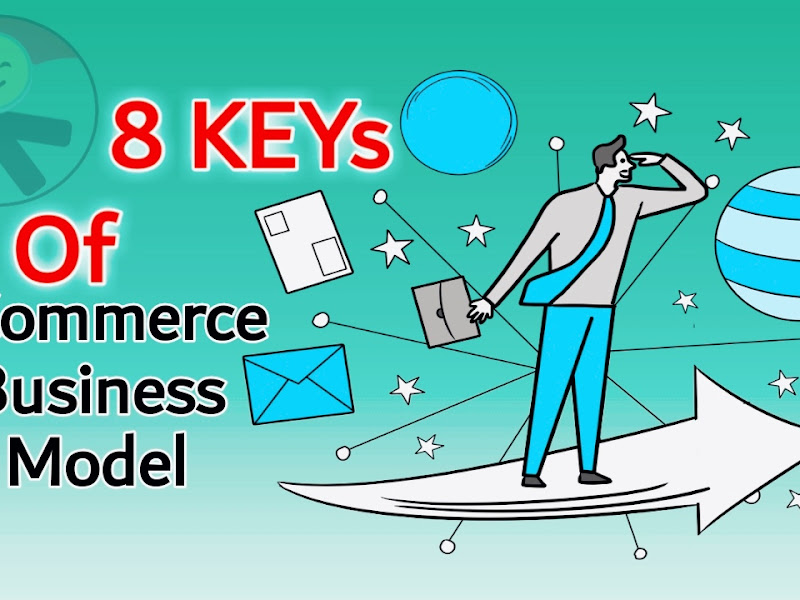Before you start any business you should take in consideration to a few pointers to kick start your business properly and make it a successful one.
First to start 8 Key elements of a Business Model, we learn about eCommerce and eBusiness
E Commerce Vs E Business
Simply we can say, e-commerce means online buying and selling, while e-business covers all online businesses.
Types of E-Commerce
They are all different types of E-COMMERCE.
1) B2B
B2B represents Business -to -Business, where a business sells goods and services to another business for example, Manufacturers sell raw materials to other firms, marketing companies, etc.
2) B2C
B2C stands for Business - to - Consumer, where the business sells its goods and services directly to the consumer such as Flipkart, Amazon, etc.
3) C2B
C2B represents the Consumer - to Business, where the business provides the consumer with a platform as they can provide details of their needs and the company tries to sell their products or services to them, or the consumer can directly choose a company to meet their needs, for example hotel booking companies, and various goods and services can choose their own company like GoIbibo, Trivago, Paisabaazar.com etc.
4) C2C
Finally, C2C represents the Consumer - to consumer , where the business provides the same platform to two or more individuals who directly engage to buy and sell their products for example, Olx.in, Quikrr, etc.
8 Key elements of a business model that you need to pay attention to

1) Value Proposition
Explain how a company's product or service affects customer demand.
Examples of successful value propositions
- Personalization/ Customization
- Reduction of product search, price discovery costs
- Facilitation of transactions by managing product delivery
2) Revenue Model
Explain how the company will earn money generating profits and generating high returns on the invested capital.
Major types:
- Advertising revenue models: CNN.com
- Subscription revenue models: MATCH.com
- Transaction fee revenue model: EBay, E-Trade, Hotwire
- Sales revenue model: Amazon, LLbean, Gap.com
- Affiliate revenue model: E-pinions, Banner Exchange, Edmunds à sends traffic to another website
3) Market Opportunity
Refers to the company's target market and all financial opportunities available to the company in that market area.
4) Competitive Environment
It refers to another competition selling the same products and operating in the same market place.
Influenced by
- How many competitors are active
- How large operations are
- The market share for each competitor
- How profitable these firms are
- How they price their product
5) Competitive Advantage
It is achieved when a company can produce a higher product and / or bring a product to market, at a lower price than most, or all, of its competitors.
Types of competitive advantage:
- First mover advantage
- Unfair competitive advantage
6) Market Strategy
Plan those details of how the company intends to enter the new market and attract strategy.
7) Organizational Development
It describes how the company will plan the work that needs to be accomplished.
8) Management Team
Employees of the company responsible for making the business model work.
- Strong management team gives instant credibility to outside investors.
There are many types of e-commerce business models lets take a look at all of them and what are the difference.
Business to Consumer Models
Portal
Provides powerful search tools and integrated content packages and services
usually use a subscription / advertising / payment fee.
E-tailer
Online type of traditional retailer
Types include:
- Virtual merchants: Amazon
- Bricks and Clicks: Borders, Wal-Mart
- Catalogue merchants: LL Bean
- Manufacturer- direct: Dell.com, Sony Style
Content Provider
Information and entertainment companies that offer digital content on the web
- They usually use subscriptions, pay downloads or the advertising revenue model
- Transactions are different from the standard content provider model.
Transaction Broker
- Processes online transactions for consumers
- Primary value proposition- saving time and money
- Pay Pal
- Tpical revenue model – transaction fee
Market Creator
It uses internet technology to create markets that bring buyers and sellers together
- E.g priceline.com & ebay.com
Service Provider
- Offers service online
- Value proposition: valuable, convenient, time-saving, low cost alternatives to traditional service providers.
- Visa Now.
- Revenue Model: Subscription fees or one-time payment.
Community Provider
Sites that create a digital online environment where people with similar interest can transact, communicate and receive interest-related information
- Angie’s List
- Typically rely on hybrid revenue model
Business to Business Models
E-distributor
- Supplies products and services directly to individual businesses.
- Owned by one company seeking to serve many customers.
E-procurement
- Creates and sells access to digital electronic markets.
- B2B services providers is one type
- Application service providers: a subset of B2B service providers.
Exchanges
- A digital marketplace where suppliers and business purchases can conduct transactions.
- Usually owned by independent firms whose business is making a market.
Industry Consortia
- A vertical industrial market place that offers certain industries.
- The horizontal market place, in contrast, sells certain products and services in a variety of industries.
Private industrial networks
- Digital networks designed to co-ordinate the flow of communications among firms engaged in business together.
- Lobbying: influence the government as a group a Public policy access.
Business models in emerging E-Commerce Areas
- Consumer to consumer: Provides a way for consumers to sell to each other, with the help of online market maker (EBay)
- Peer to peer (P2P): Connect users, enable them to share files with common resources outside of the normal server (Kazaa, Cloudmark)
- M-Commerce: E-commerce business models that use wireless technologies (EBay Mobile)—To date, m-commerce is a disappointment in the united states however, united states but, technology is still emerging.
